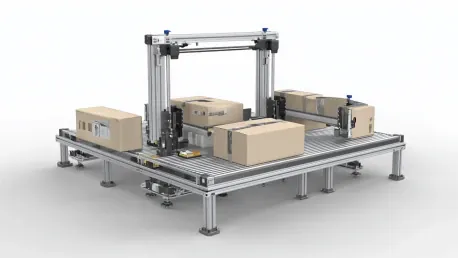The e-commerce sector is undergoing a significant transformation, driven by the rise of automated packaging solutions. These advanced systems are not only enhancing efficiency and cost-effectiveness but also playing a crucial role in promoting sustainability. As the demand for online shopping continues to surge, the need for innovative packaging solutions that can keep pace with this growth while minimizing environmental impact has never been more critical.
The Rise of Automated Packaging in E-Commerce
North America’s Market Dominance
In 2023, North America emerged as the leader in the automated e-commerce packaging market. This dominance is largely due to the region’s rapid adoption of advanced packaging technologies and a robust e-commerce infrastructure. Companies in North America are leveraging these technologies to streamline their packaging processes, reduce labor costs, and enhance overall efficiency. The presence of established e-commerce giants and a tech-savvy consumer base further fuels this growth, making North America a key player in the global market.
The advanced supply chain management systems and logistical frameworks prevalent in North America offer a conducive environment for the integration of automated packaging solutions. These technologies help businesses address the challenges of scaling operations to meet increasing consumer demands. Moreover, regulatory policies promoting sustainability and innovation play a pivotal role in incentivizing manufacturers and retailers to adopt automated systems. Consequently, North America’s leading position in the market underscores its commitment to driving efficiency and sustainability in e-commerce packaging.
Asia Pacific’s Promising Growth
The Asia Pacific region is poised for significant growth in the automated packaging market. Countries like China, India, and those in Southeast Asia are experiencing a rapid expansion of e-commerce, driving the demand for efficient packaging solutions. This growth trajectory is expected to accelerate, presenting substantial opportunities for businesses in the region. The burgeoning middle class, rising internet penetration, and increased consumer spending are key factors contributing to this upward trend.
Local governments in Asia Pacific are also investing in infrastructure and technological advancements to support the expanding e-commerce sector. Additionally, the region’s competitive labor market and manufacturing capabilities provide a strong foundation for the development and deployment of automated packaging systems. Companies operating in this dynamic environment can achieve significant operational benefits by adopting these advanced solutions, enabling them to cater to the diverse needs of a fast-growing online consumer base while adhering to sustainability goals.
Understanding Automated E-commerce Packaging
Automated e-commerce packaging is revolutionizing the shipping industry by reducing manual labor and increasing efficiency. This advanced technology involves the use of automated systems to pack and seal products, ensuring they are secure and properly protected during transit. Automated packaging solutions can handle a wide range of product sizes and shapes, making them versatile for various e-commerce businesses. The implementation of such systems not only speeds up the fulfillment process but also reduces human error, leading to greater customer satisfaction. Furthermore, automated packaging can be more environmentally friendly, as it often optimizes the use of packing materials, reducing waste.
Key Functions of Automated Packaging Systems
Automated e-commerce packaging systems incorporate sophisticated machinery to automate essential steps in the packaging process. These systems handle tasks such as measuring, packing, sealing, and labeling with remarkable precision, thereby streamlining operations and reducing human error. By integrating these functions, businesses can achieve faster and more accurate order fulfillment, ensuring products are well-protected during transit. This level of efficiency is crucial in the e-commerce market, where fast and reliable delivery is a major competitive advantage.
The precise handling and packaging provided by automated systems also contribute to a significant reduction in material waste, promoting sustainable practices. As packaging processes become more efficient, companies can optimize material usage, minimize costs, and improve their overall environmental footprint. The automated approach allows for customization and scalability, adapting to the varying demands of different product types and order volumes. This flexibility is essential for businesses seeking to maintain high standards of service while managing growth effectively.
Benefits of Automation
The adoption of automated packaging systems offers numerous benefits, among which enhanced efficiency is one of the most significant. These systems can significantly speed up the packaging process, enabling businesses to keep pace with the growing volume of orders. Additionally, automation reduces labor costs and minimizes material waste, leading to substantial savings. For businesses operating in highly competitive markets, these cost efficiencies are critical in maintaining profitability and ensuring long-term sustainability.
Automated systems also ensure consistent quality, reducing the likelihood of packaging errors and enhancing customer satisfaction. By eliminating human error, these systems improve the accuracy of order fulfillment, leading to higher levels of customer trust and loyalty. The ability to handle large volumes of orders quickly and accurately positions businesses to meet the rising expectations of modern consumers. Furthermore, the integration of automated packaging solutions can enhance supply chain resilience, providing the agility needed to adapt to market fluctuations and disruptions.
Drivers of Market Growth
Surge in E-commerce Sales
The post-pandemic surge in online shopping has heightened the demand for efficient packaging solutions. Automated systems enable businesses to handle larger order volumes without compromising speed or accuracy. This capability is crucial in meeting the growing expectations of consumers for quick and reliable deliveries. As more people turn to online shopping for convenience and accessibility, the pressure on businesses to optimize their packaging processes and delivery timelines intensifies.
The scalability offered by automated packaging systems allows companies to manage peak demand periods effectively, such as holiday seasons or promotional events. By maintaining high levels of operational efficiency, businesses can ensure timely deliveries and prevent bottlenecks in the supply chain. This responsiveness not only enhances customer satisfaction but also strengthens brand reputation in a competitive marketplace. Additionally, the ability to process orders rapidly and accurately supports inventory management, reducing the risk of overstocking or stockouts.
Demand for Customization
As consumers increasingly seek personalized packaging, automated systems capable of meeting varying requirements offer a competitive advantage. These systems can easily adapt to different packaging needs, providing businesses with the flexibility to cater to diverse customer preferences. Personalization has become a key differentiator in the e-commerce sector, with consumers valuing unique and customized experiences. Automated systems enable businesses to offer this level of personalization at scale, enhancing customer engagement and loyalty.
The versatility of automated packaging solutions allows businesses to experiment with various packaging designs and materials, aligning with brand identity and sustainability goals. Customization options can range from personalized messages and branding elements to tailored packaging sizes that reduce waste. By leveraging automation, companies can efficiently implement these features, creating memorable unboxing experiences for customers. This focus on personalization not only boosts customer satisfaction but also drives repeat business and positive word-of-mouth referrals.
Technological Innovations in Automated Packaging
Technological advancements in automated packaging have revolutionized the way products are packaged, enhancing efficiency and precision. These innovations include robotic arms for intricate packing tasks, advanced sensors for quality control, and machine learning algorithms for optimizing packing processes. As a result, companies can achieve faster production rates, improved accuracy, and reduced labor costs, ultimately leading to increased profitability and customer satisfaction.
Robotic Arms
Robotic arms are revolutionizing the packaging process by providing high-speed, precise handling of goods. These advanced machines enhance overall efficiency and ensure that products are packaged securely and accurately. The integration of robotic arms in packaging lines reduces the reliance on manual labor, which can be error-prone and time-consuming. By automating the handling and movement of products, businesses can achieve greater consistency and scalability in their operations.
Robotic arms are equipped with advanced sensors and control systems that enable them to perform complex tasks with high precision. These capabilities are particularly beneficial in handling delicate or irregularly shaped items, ensuring that products are not damaged during the packaging process. The versatility of robotic arms allows them to be integrated into various stages of the packaging line, from picking and placing items to sealing and labeling. This comprehensive automation solution enhances operational efficiency and supports high-volume production.
AI-Powered Systems
AI-powered systems are transforming various industries by enhancing efficiency, accuracy, and decision-making processes. These systems leverage machine learning algorithms and vast data sets to perform tasks that traditionally required human intelligence, from natural language processing to predictive analytics. As technology continues to evolve, the integration of AI into everyday applications is expected to grow, leading to further advancements and innovations.
Artificial intelligence is playing a pivotal role in optimizing the packaging process. AI-powered systems facilitate improved decision-making, enabling businesses to streamline their operations and reduce errors. These systems can analyze data in real-time, making adjustments to enhance efficiency and accuracy. AI algorithms can identify patterns and trends in packaging processes, allowing companies to implement predictive maintenance and reduce downtime.
The integration of AI in automated packaging systems supports advanced capabilities such as machine learning and adaptive control. These technologies enable systems to learn from historical data and continuously improve their performance. For example, AI can optimize the arrangement of products within a package to maximize space utilization and minimize material usage. Additionally, AI-powered systems can provide insights into consumer preferences and packaging requirements, helping businesses tailor their strategies to meet market demands.
3D Scanning
3D scanning technology ensures accurate measurement of product dimensions, allowing for customized packaging solutions. This technology is particularly beneficial for businesses that need to package products of varying sizes and shapes, ensuring that each item is securely packaged. By capturing precise measurements, 3D scanning enables the creation of packaging templates that fit products perfectly, reducing the risk of damage during transit.
The application of 3D scanning in automated packaging systems enhances the flexibility and adaptability of packaging processes. Businesses can quickly adjust their packaging designs to accommodate new products or respond to changing market demands. The ability to produce custom-fit packaging on demand improves operational efficiency and reduces material waste. Moreover, 3D scanning technology can be integrated with other automated systems, such as robotic arms and AI-powered platforms, creating a seamless and highly efficient packaging workflow.
Sustainability Trends
Eco-Friendly Materials
Eco-friendly materials are becoming increasingly important as people seek sustainable alternatives to traditional products. These materials often have a lower environmental impact and can be recycled or renewed more easily. Using eco-friendly materials not only helps reduce waste but also conserves natural resources and reduces pollution.
As the demand for sustainable packaging solutions escalates, automated systems that use eco-friendly materials are gaining traction. These systems help businesses comply with stringent environmental regulations and meet consumer preferences for greener solutions. The integration of recyclable and biodegradable materials in automated packaging processes supports sustainability goals. By reducing reliance on single-use plastics and other non-recyclable materials, companies can significantly lower their environmental impact.
The adoption of eco-friendly materials in automated packaging systems also aligns with corporate social responsibility initiatives and brand values. Businesses that prioritize sustainable practices can enhance their reputation and appeal to environmentally conscious consumers. Automated systems enable efficient handling and processing of eco-friendly materials, ensuring that packaging operations remain cost-effective and sustainable. As consumers increasingly demand greener products, companies that invest in sustainable packaging technologies are better positioned to capture market share and build long-term brand loyalty.
Optimizing Material Usage
Automated packaging systems are designed to optimize material usage, reducing waste and promoting eco-friendly practices. By minimizing the amount of packaging material required, businesses can significantly reduce their environmental footprint while also achieving cost savings. These systems use advanced algorithms and precision engineering to ensure that each package is tailored to the product’s dimensions, eliminating excess material and reducing waste.
The optimization of material usage in automated packaging systems also contributes to overall supply chain efficiency. By reducing the volume and weight of packaging, businesses can lower transportation costs and improve logistics. This not only enhances operational efficiency but also reduces greenhouse gas emissions associated with shipping. Automated systems can continuously monitor and adjust packaging processes to ensure optimal material usage, supporting ongoing sustainability efforts and compliance with environmental regulations.
E-commerce Purchase Trends
Global Online Shopping Growth
In 2023, 2.71 billion people made online purchases globally, a number expected to grow to 2.77 billion by 2025. This growth is driven by increased internet accessibility and consumer convenience. By 2024, 20.1% of retail transactions are projected to occur online, with e-commerce revenues surpassing $6.3 trillion. The surge in online shopping has created significant opportunities for businesses to expand their reach and cater to a global consumer base.
The rise in e-commerce has also intensified the need for efficient and reliable packaging solutions that can support large-scale order fulfillment. As consumers increasingly rely on online shopping for daily necessities, businesses must ensure that their packaging processes can keep up with the demand. Automated systems offer the scalability and flexibility needed to handle high volumes of orders while maintaining high standards of quality and efficiency. This is essential for businesses seeking to thrive in a rapidly evolving digital marketplace.
Leading Markets
The US and China are expected to lead online purchase volumes, with 270.11 million and 915.1 million consumers respectively. These markets are setting the pace for e-commerce growth, driving the demand for advanced packaging solutions that can keep up with the increasing order volumes. The significant consumer base in these countries presents lucrative opportunities for businesses to tap into new segments and expand their market presence.
Both the US and China have well-developed e-commerce ecosystems and logistical infrastructures that support the adoption of automated packaging technologies. Companies operating in these markets benefit from favorable regulatory environments and access to cutting-edge technological advancements. As leading e-commerce markets, the US and China also set trends and standards that influence global packaging practices. Businesses that invest in automated packaging solutions can gain a competitive edge by offering superior service and meeting the evolving expectations of consumers in these dynamic markets.
Challenges in the Market
The market is facing several significant challenges that are impacting investor confidence and overall economic stability. These challenges include geopolitical tensions, fluctuating interest rates, and unpredictable trade policies, all of which contribute to a climate of uncertainty. Additionally, technological advancements and the rapid pace of innovation are disrupting traditional industries, forcing companies to adapt quickly or risk obsolescence. This dynamic environment requires keen strategic planning and robust risk management practices to navigate successfully.
High Initial Costs
Despite the numerous benefits, the significant investment required for installing automated systems can be a barrier for some businesses. The high initial costs may deter smaller companies from adopting these technologies, limiting their ability to compete with larger players. The financial strain associated with purchasing, installing, and maintaining automated systems can be substantial, posing a challenge for businesses with limited resources.
However, the long-term benefits of automated packaging systems, such as cost savings, enhanced efficiency, and improved sustainability, can outweigh the initial investment. Companies must carefully evaluate the potential return on investment and consider financing options or partnerships to mitigate the upfront costs. Additionally, advancements in technology and increased competition in the market may lead to more affordable and accessible automated solutions over time.
Integration Issues
Ensuring compatibility with existing logistics and IT systems can be complex. Businesses may face challenges in integrating automated packaging systems with their current operations, requiring significant time and resources to achieve seamless integration. The need to align new technologies with established workflows, software platforms, and supply chain processes can create logistical hurdles.
To overcome integration challenges, companies must invest in comprehensive planning, training, and support. Collaboration with technology providers and experts can facilitate a smooth transition and minimize disruptions. Implementing phased integration strategies and robust testing protocols can also help businesses identify and address potential issues early on. The successful integration of automated packaging systems can ultimately enhance operational efficiency and support long-term growth.
Technological Dependence
Over-reliance on technology may cause operational disruptions during system failures. Businesses must have contingency plans in place to address potential issues and maintain continuity. Dependence on automated systems requires robust maintenance and support mechanisms to ensure consistent performance and minimize downtime. The complexity and sophistication of these systems necessitate regular updates, monitoring, and troubleshooting.
To mitigate the risks associated with technological dependence, businesses should establish comprehensive maintenance schedules and invest in skilled personnel trained to manage and repair automated systems. Backup systems and manual processes can serve as critical safeguards during unexpected failures. By proactively addressing potential vulnerabilities and implementing redundancy measures, companies can enhance the resilience of their packaging operations and ensure uninterrupted service to customers.
Conclusion
The e-commerce industry is experiencing a major shift, largely due to the emergence of automated packaging solutions. These advanced packaging systems are significantly enhancing operational efficiency and reducing costs, making them a valuable asset for businesses. Moreover, they are playing a vital role in the push for sustainability. As more consumers turn to online shopping, the demand for innovative packaging solutions that can handle the increased volume while minimizing environmental damage has never been more urgent. Automated packaging can reduce waste, lower carbon footprints, and improve the overall sustainability of e-commerce operations. These systems streamline the packaging process, save time, and reduce labor costs, enabling companies to fulfill orders more quickly and accurately. By optimizing packaging materials and reducing excess, automated solutions also contribute to better resource management and reduced waste. Therefore, the rapid growth of e-commerce is making the development and adoption of such sustainable packaging technologies a top priority for the industry.









